Menus
- Who makes whom wet here??
- Husqvarna FE 250 in the golden mean?
- The more difficult the terrain, the greater the differences
- After the forest there is a cross area
- Husqvarna and KTM share the victory
- Data and measured values
- Gas Gas EC 250 F Racing
- Husqvarna FE 250
- KTM 250 EXC-F
- Off-road rating
- Test result and conclusion
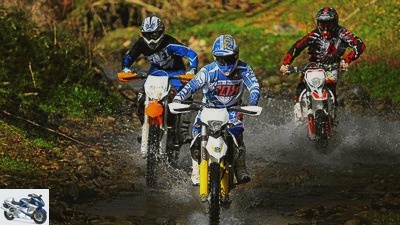
Zamponi
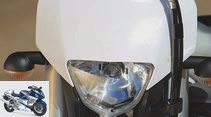
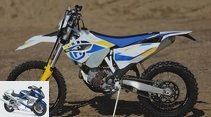
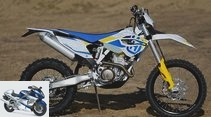
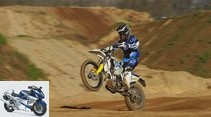
45 photos
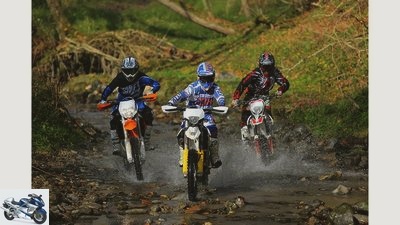
Zamponi
1/45
Off with the sports enduro into a huge private forest! Contrary to popular belief, enduro riding is prohibited in public areas as well as in this country.
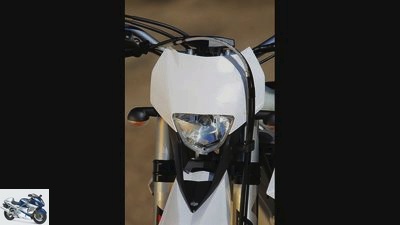
Zamponi
2/45
The Husqvarna FE 250 is equipped with a single-loop frame made of tubular steel.
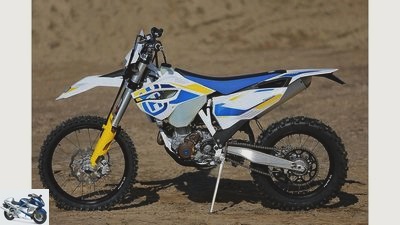
Zamponi
3/45
Above all, the suspension strut operated via a reversing lever is very different.
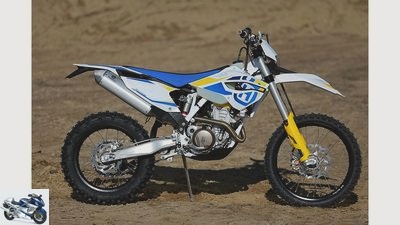
Zamponi
4/45
The few differences to the KTM in the Husqvarna FE 250: a plastic rear frame, a so-called 4CS fork from WP Suspension with milled fork bridges.
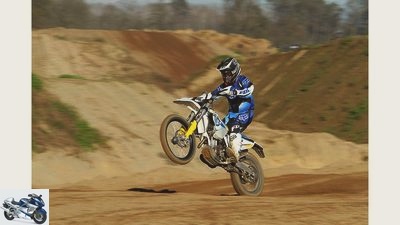
Zamponi
5/45
The huskies focus on the traditional enduro sport.
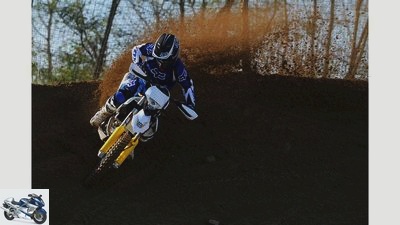
Zamponi
6/45
Raise your cups: Husqvarna is not only taking over the position, but also the role of Husaberg in the KTM group.
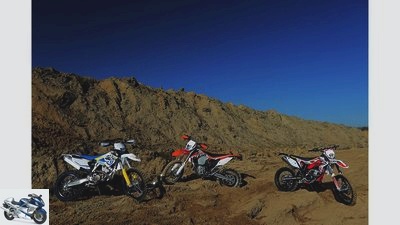
Zamponi
7/45
Who is ahead here? The Husqvarna FE 250, the KTM 250 EXC-F and the Gas Gas EC 250 F Racing were tested (from left to right).

Zamponi
8/45
The KTM 250 EXC-F weighs 109 kilograms.
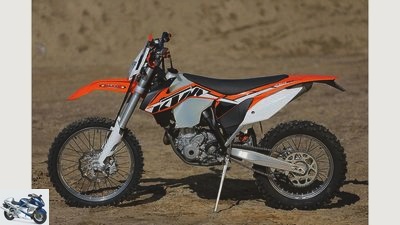
Zamponi
9/45
The water-cooled single-cylinder four-stroke engine with four valves of the KTM 250 EXC-F has an output of 37 hp.
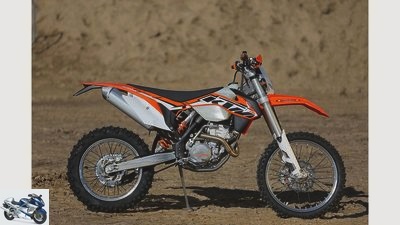
Zamponi
10/45
Because the intake snorkel between the air filter and the throttle valve body on the KTM is straighter due to the off-center positioned PDS strut, the response behavior of the EXC-F motor is noticeably more spontaneous and also livelier than the mechanically and electronically identical drive in the Husky.
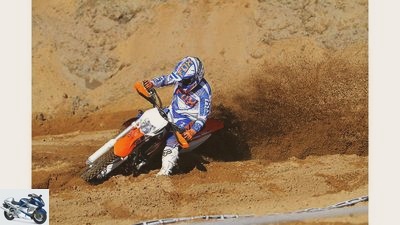
Zamponi
11/45
The KTM enduro bikes don’t want to be meek. Compared to Gas Gas, in particular, the KTM 250 EXC-F rumbles roughly over the pebble mosaic.
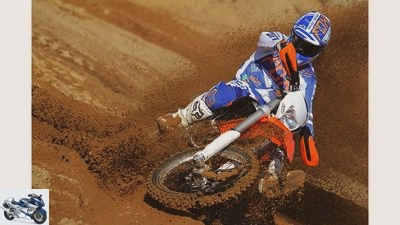
Zamponi
12/45
Wild instead of mild: The focus of the KTM250 EXC-F is clearly on cross country use.
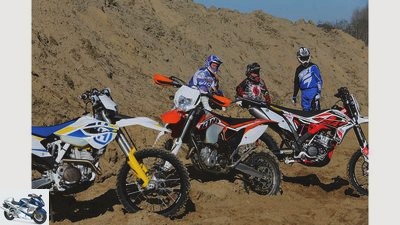
Zamponi
13/45
Full throttle is out of the question on this terrain.
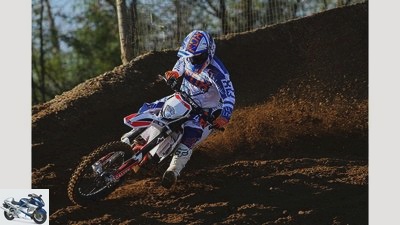
Zamponi
14/45
The lower price of the Gas Gas EC 250 F Racing no longer compensates for this difference.
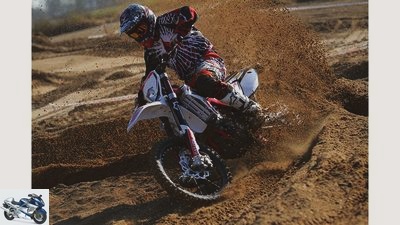
Zamponi
15/45
The concentrated storm from Austria blows the Gas Gas EC 250 F Racing off the field.
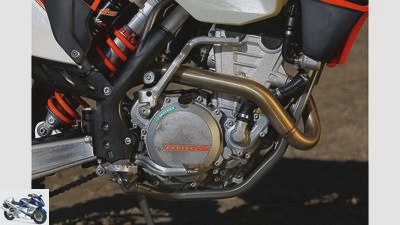
Zamponi
16/45
Same but different: the KTM engine is more dependent on the gas than the Husky single. The intake tract does it.

Zamponi
17/45
Direct mandate: The directly hinged shock absorber has been the trademark of KTM enduros for years.
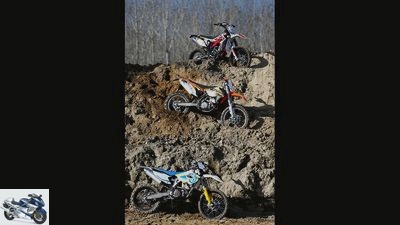
Zamponi
18/45
The Gas Gas EC 250 F Racing took last place. Despite the attractive appearance and moderate price, the Spaniard needs one thing above all: a more modern engine.
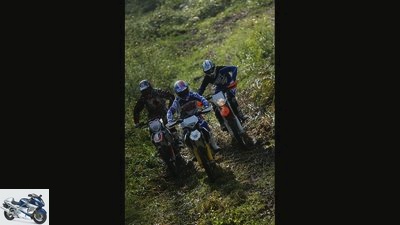
Zamponi
19/45
Husqvarna and KTM emerged as winners.
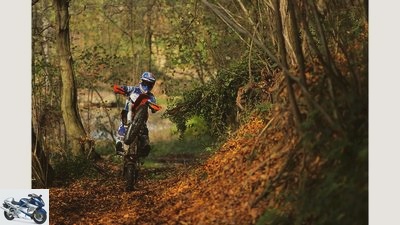
Zamponi
20/45
Tight suspension and a livelier engine make it ideal for the hunt on cross-country slopes.
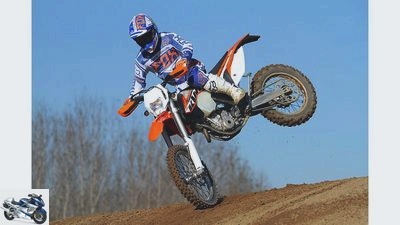
Zamponi
21/45
Despite its technical proximity, the KTM does not climb onto the podium from the same side as the Husky.
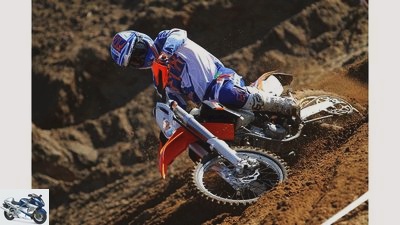
Zamponi
22/45
The lowest weight ensures the best handling.

Zamponi
23/45
The suspension offers the greatest reserves.
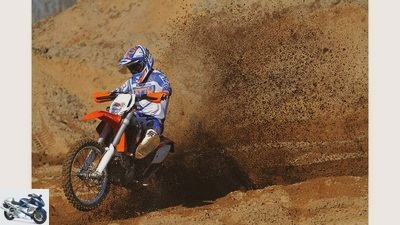
Zamponi
24/45
The KTM single is the most aggressive.
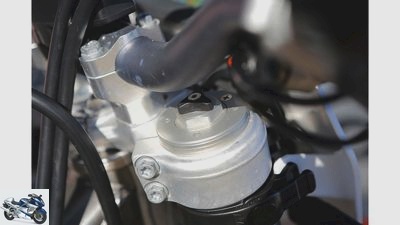
Zamponi
25/45
Closed society: The tuning of the KTM fork offers the most reserves in the test field.
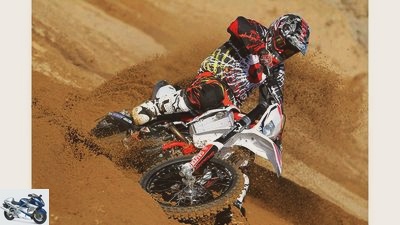
Zamponi
26/45
However, the tame Yamaha engine slows the Spaniard down.
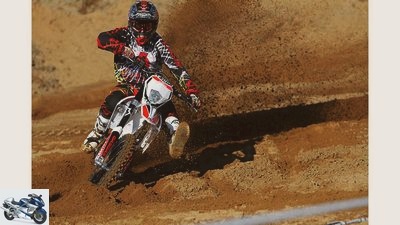
Zamponi
27/45
And the Reiger shock absorber also pleases with its fine response behavior under these conditions.

Zamponi
28/45
Casus cracksus: The deflection is the most important detail that distinguishes the Husqvarna from the KTM. It’s better with leverage.
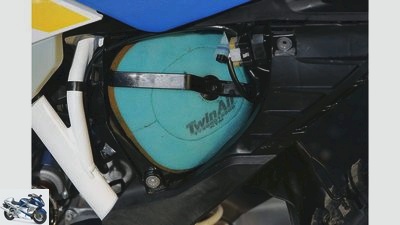
Zamponi
29/45
Plastic and elastic: The plastic frame rear should show its elasticity in the event of a fall.
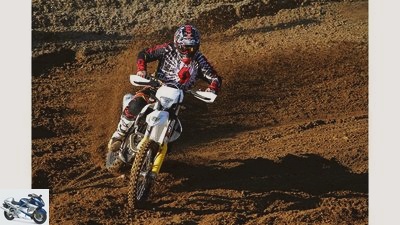
Zamponi
30/45
Husqvarna straddles the gap between Gas Gas and KTM.

Zamponi
31/45
Tighter than the Spaniard, but softer than its sister, the FE 250 hits the golden mean, so to speak.

Zamponi
32/45
in the
Comparison works with the thinner piston rod (8 instead of 12 mm) as well
Lower spring preload, the Husky’s 4CS fork, which is specially designed for enduro sports, is noticeably more comfortable than its closed cartridge counterpart in the KTM, which is also from WP Suspension.
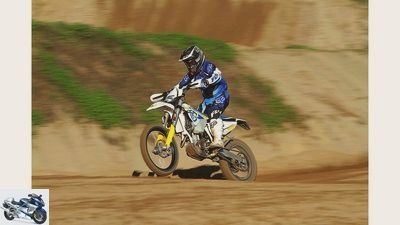
Zamponi
33/45
The husky’s hindquarters can easily cope with small waves and offer noticeably more comfort in these situations.
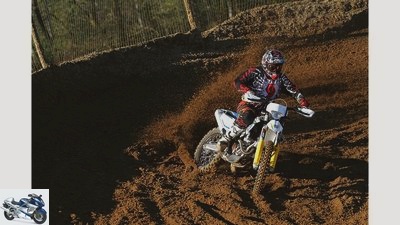
Zamponi
34/45
The FE creates a lot of sympathy on the bumpy slope.

Zamponi
35/45
The machines are all species-appropriate with Metzeler MCE 6 Days Extreme and have identical tires.
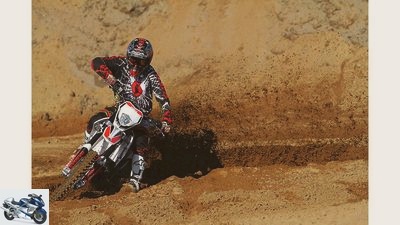
Zamponi
36/45
Against the overwhelming power: With a lot of commitment Gas Gas braces itself against the Austrian domination.

Zamponi
37/45
The Gas Gas EC 250 F Racing with its deliberately soft suspension easily sniffs up even the roughest chunks.

Zamponi
38/45
The double loop frame, which was lightened by two kilograms for the 2014 season, contains the engine of the Yamaha WR 250 F, which is still supplied by a carburetor instead of injection, and for the first time a shock absorber from the Dutch supplier Reiger.
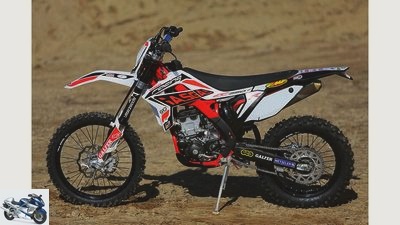
Zamponi
39/45
In addition, the contour of the new tank is visibly flatter than that of the previous model.
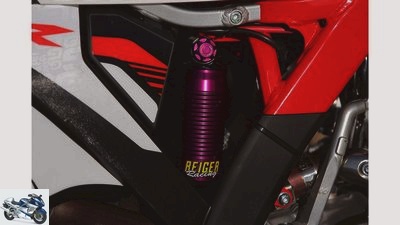
Zamponi
40/45
Lila Sause: little known, but at the forefront in terms of quality – the Dutch Reiger struts.
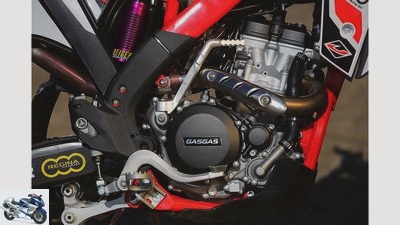
Zamponi
41/45
The water-cooled single-cylinder four-stroke engine with five valves of the Gas Gas EC 250 F Racing has an output of 35 hp.
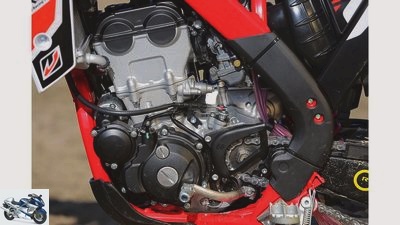
Zamponi
42/45
Old comrade: The gas engine comes from Yamaha. The five-valve engine still has a carburetor.
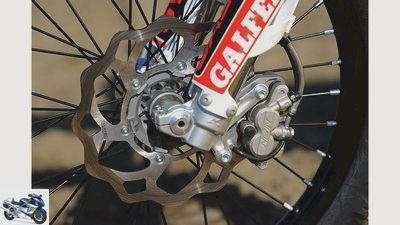
Zamponi
43/45
Stop: The Nissin brake cannot compete with the current Brembo stoppers (KTM, Husky).
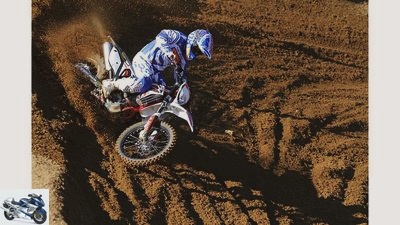
Zamponi
44/45
Even the Marzocchi fork of the Gas Gas EC 250 F Racing, which reacted a bit unsteadily when pressed while standing, rehabilitates itself while driving with its comfortable setup.
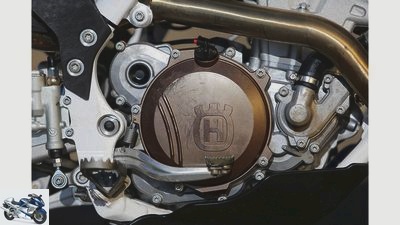
Zamponi
45/45
The Husky is powered by a water-cooled single-cylinder four-stroke engine with four valves that produces 38 hp.
250 cc sports enduro bikes from Gas Gas, Husqvarna and KTM put to the test
Who makes whom wet here??
In sport it is all about one thing: who makes whom wet? KTM has significantly improved the new 250 and is also sending Husqvarna into the field for the 2014 season. Can the Gas Gas as one of the few opponents still hold back?
E.It’s just ten kilometers as the crow flies to the Swiss border, and yet we feel as if Varese is a day’s journey south of Rome. Maybe this impression is due to Martino Bianchi, our guide. Because Martino, team principal of the current Dakar rally project from Honda, has lived in Varese for 30 years and knows Hinz and Kunz here. Fortunately, the forest owners too. Because contrary to popular belief, enduro riding is prohibited in public areas in Italy as well as in this country. With the blessing of the local forest magnate, we roll unmolested through a huge private forest on the three 250 cm³ enduro bikes.
Buy complete article
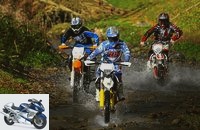
250 cc sports enduro bikes from Gas Gas, Husqvarna and KTM put to the test
Who makes whom wet here??
No 250cc four-stroke enduro bikes from Beta, Kawasaki and Suzuki
In this respect, the Gas Gas EC 250 F Racing can be seen as a face in the crowd, even in this small group. The double loop frame, which was lightened by two kilograms for the 2014 season, contains the engine of the Yamaha WR 250 F, which is still powered by a carburetor instead of injection, and for the first time a shock absorber from the Dutch supplier Reiger. In addition, the contour of the new tank is visibly flatter than that of the previous model. Who is missing? Beta, Kawasaki and Suzuki do not offer 250cc four-stroke enduros, Yamaha will stop production of the WR 250 F at the end of this year, the Italian Honda off-road branch HM is currently struggling with economic difficulties, and TM Racing is only delivering the 2014 models At the end of the year. Sherco was reluctant to provide a test machine for this comparison. It’s a shame, because French bikes now have a good reputation.
Zamponi
Who is ahead here? The Husqvarna FE 250, the KTM 250 EXC-F and the Gas Gas EC 250 F Racing were tested (from left to right).
Back to the three present. Narrow single tracks all branch off the gravel path for a long time. What are we waiting for? The machines are all species-appropriate with Metzeler MCE 6 Days Extreme and have identical tires. So go ahead, turn right. Again and again stones peek out of the ground between the leaves, deeply rinsed gullies cross the path in every corner. Enduro terrain at its finest. Full throttle? Don’t think about it. Instead, let the machine roll, hold it loosely and occasionally lift the front wheel over the roughest holes with a gentle throttle. With its deliberately soft suspension, the Gas Gas sniffs every chunk, no matter how large. Even the Marzocchi fork, which reacted a bit unsteadily when pressed while standing, rehabilitates itself while driving with its comfortable setup. And the Reiger shock absorber also pleases with its fine response behavior under these conditions.
Husqvarna FE 250 in the golden mean?
KTM enduros have never wanted anything to do with meekness. Compared to Gas Gas, the EXC-F rumbles roughly over the pebble stone mosaic, and its suspension travel can only be nibbled off at the fork and shock absorber a little. You can feel that more extreme challenges are required to lure them from their reserves. Husqvarna straddles the gap between Gas Gas and KTM. Tighter than the Spaniard, but softer than its sister, the FE 250 hits the golden mean, so to speak.
In comparison, the Husky’s 4CS fork, which has a thinner piston rod (8 instead of 12 mm) and a lower spring preload, is especially designed for enduro sports, and works noticeably more comfortably than its closed cartridge counterpart in the KTM, which is also from WP Suspension. And thus fits in with the equally sensitive monoshock. It’s not surprising. Because even if the PDS of the KTM enduros has eliminated the teething troubles for years, the Husky diversion, which has proven itself in KTM’s motocross models since the 2012 season, is immediately superior to the PDS. The husky hindquarters can cope with small waves more easily and offers noticeably more comfort in these situations. And because the front fork also responds more sensitively and the damping curve, both front and rear, is significantly smoother than that of the two competitors, the FE gets a lot of sympathy on the bumpy slope. However: Of the three kilograms difference in weight between the Husky (112 kg) and the KTM (109 kg), a good part is likely to be due to the leverage.
The more difficult the terrain, the greater the differences
But their influence is even greater. Because the more difficult the terrain, the more striking the difference between the two Austrians’ driving behavior. While the KTM, which feels light in the front, needs an active pilot who directs it forward like a trial machine with cleverly placed throttle strokes and accentuated physical effort, the Husqvarna seems to remember the traditional values of the brand. Stoically calm and with strong traction, she plows through the scree. The front section feels heavier, but convinces with precise steering behavior. This orientation is particularly useful for less experienced pilots. The Gas Gas is not a slouch here either, it pleases with its comfort, but when the pace is accelerated, its soft spring elements pump its way through the spring travel much more excitedly.
Zamponi
Raise your cups: Husqvarna is not only taking over the position, but also the role of Husaberg in the KTM group.
Especially since the Catalan does not make the game with throttle and clutch easy in tricky terrain. In the lower rev range, the five-valve engine chokes in spite of the carefully adjusted mixture control screw on the carburettor, and even breaks below 4000 rpm on the test bench (see diagram on page 65). Even above this threshold, the Yamaha single accelerates comparatively tame, irritated by a high drag torque when releasing the gas and giving the gas a feeling of inertia. In situations like this, it is hard to believe that the EC weighs just one kilo more than the Husqvarna at 113 kilograms. Not even how much even the smallest technical differences affect the sharpened character of competitive machines. Because the intake snorkel between the air filter and the throttle valve body on the KTM is straighter due to the off-center PDS strut, the response behavior of the EXC-F motor is noticeably more spontaneous and also livelier than the mechanically and electronically identical drive in the Husky. Even if the performance curves measured under full load do not reflect this.
However, while with larger cubic capacities a smooth start usually makes the job easier in demanding terrain, the smoother use is hardly significant given the performance level of the 250 class, which is much easier for the driver to master.
After the forest there is a cross area
A shallow stream borders our playground. Get wet once? OK. Again the gas rumbled unimpressed over the smooth stones, showing itself as enduro in the most traditional sense. The Husky also signals relaxation again, easily coping with the incalculable blows dealt by the underwater world, while the stiffer KTM – as expected – needs a determined hand from the pilot to stay on course.
The forest is finally behind us. Martino knows that the focus in enduro sport is shifting more and more in Italy and especially in Germany. The decision about victory or defeat is rarely decided by the souplesse on the intermediate stages, but by the result in the special stages. Especially since many enduro cracks concentrate entirely on the popular cross country events. And the vast majority of enduro riders only have to sprint on the motocross slopes for training. That means: Modern enduros have to prove themselves on demanding motocross slopes. Therefore, after a few kilometers, we turn onto a cross-area. Soft sand, rock-hard clay, jumps – the track offers the whole repertoire of off-road racing. And if the bikes were still relatively close together in the wild, despite all the differences in character, the field of three suddenly spreads like a fan under these aggravated conditions.
Gas gas in particular is quickly reaching its limits on the tighter ride. Even when the pressure level is completely turned down, the Marzocchi fork goes into a metallic block on hard landings. And the Reiger monoshock cannot deny its basic endurance set-up, despite the huge range of damping settings, and works its way into the progressive and therefore uncomfortable range in acceleration waves. Even the engine seems to resist the strange terrain, with 35 HP it only has a little peak performance, but it lacks even more pep for intermediate sprints before jumps or for the stabilizing thrust in washboards. In short: The Yamaha single, which has not been further developed for ten years, is legendary and steadfast, but it hardly manages to keep up with the modern competition.
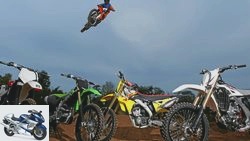
Enduro
KTM 250 SX-F, Husqvarna TC 250 R, Kawasaki KX 250 F, Suzuki RM-Z 250, Yamaha YZ 250 F
Motocross comparison test MX2 (250 cm³)
read more
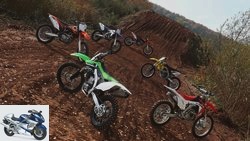
Enduro
Motocross comparison test MX1 (450 cm³)
Motocrossers from Honda, Kawasaki, KTM, Suzuki and Yamaha
read more
Husqvarna and KTM share the victory
Especially since the two Austrians are in impressive form, although they also differ in their orientation here. Because with the aforementioned precisely steered front section, the Husky sticks razor-sharp into the ruts and slides dreamily around every corner. Blemish: The higher rear when driving (sag with driver: 94 mm) does not allow the FE to find traction as effectively on slippery passages as the lower hindquarters of the KTM (sag with driver: 110 mm). Which the Husky would still be able to get over with the easily manageable level of performance of the quarter-liter bikes. Because the Husqvarna sets the limits here, above all, with its more comfort-oriented suspension set-up, which causes unrest in the chassis on the rough slopes. The fact that the Husky engine hangs a little more slowly on the gas than the KTM propellant is much more noticeable on the motocross slope than in the undergrowth. Which is why the EXC-F does not make a lot of pen reading with its colleagues at this point. The KTM single tackles the most aggressively, the suspension offers the greatest reserves, and the lowest weight ensures the best handling.
Which means that the KTM, which is somewhat distant from the Husqvarna in the open terrain, is on the same level as its sister on the motocross track and thus ensures a double victory for the bikes from Mattighofen. Even if the two winners are approaching the podium from very different directions. While the EXC-F continues to focus on the racing-oriented clientele, the FE has its strengths in the traditionally oriented enduro sport. And the gas gas? Despite an attractive appearance and moderate price, it needs one thing above all else: a more modern engine.
Data and measured values
BILLION
Although the performance curves of the Husqvarna and KTM differ only minimally, in practice the KTM engine depends better on the gas than that of the Husky. The Yamaha engine in the Gas Gas has to give way at the high level of the two Austrians. Speaking of level: MOTORRAD measured the 250 cm³ motocross model from KTM with a peak power of 45 hp!
Gas Gas EC 250 F Racing
Zamponi
The double loop frame, which was lightened by two kilograms for the 2014 season, contains the engine of the Yamaha WR 250 F, which is still supplied by a carburetor instead of injection, and for the first time a shock absorber from the Dutch supplier Reiger.
engine
| design type | water-cooled single cylinder- Four-stroke engine with five valves |
| Valve train |
dohc
landing gear
| frame | Double loop frame made of tubular steel |
| fork | Marzocchi |
| Guide tube diameter | 48 mm |
| Strut | Reiger |
| Weight (without petrol) * | 113 kg |
| Price without additional costs | 7,995 euros |
| * MOTORCYCLE measurements; ** Power on the crankshaft. Measurements on Dynojet roller dynamometer 250, corrected according to 95/1 / EG, maximum possible deviation ± 5% |
|
Husqvarna FE 250
Zamponi
The few differences to the KTM in the Husqvarna FE 250: a plastic rear frame, a so-called 4CS fork from WP Suspension with milled fork bridges.
engine
| design type | water-cooled single cylinder- Four-stroke engine with four valves |
| Valve train |
dohc
landing gear
| frame | Single-loop frame made of tubular steel |
| fork | WP suspension |
| Guide tube diameter | 48 mm |
| Strut | WP suspension |
| Weight (without petrol) * | 112 kg |
| Price without additional costs | 9,245 euros |
| * MOTORCYCLE measurements; ** Power on the crankshaft. Measurements on Dynojet roller dynamometer 250, corrected according to 95/1 / EG, maximum possible deviation ± 5% |
|
KTM 250 EXC-F
Zamponi
Because the intake snorkel between the air filter and the throttle valve body on the KTM is straighter due to the off-center positioned PDS strut, the response behavior of the EXC-F motor is noticeably more spontaneous and also livelier than the mechanically and electronically identical drive in the Husky.
engine
| design type | water-cooled single cylinder- Four-stroke engine with four valves |
| Valve train |
dohc
landing gear
| frame | Single-loop frame made of tubular steel |
| fork | WP suspension |
| Guide tube diameter | 48 mm |
| Strut | WP suspension |
| Weight (without petrol) * | 109 kg |
| Price without additional costs | 8945 euros |
| * MOTORCYCLE measurements; ** Power on the crankshaft. Measurements on Dynojet roller dynamometer 250, corrected according to 95/1 / EG, maximum possible deviation ± 5% |
|
Off-road rating
Zamponi
Full throttle is out of the question on this terrain.
engine
| Maximum Point count |
Gas gas EC 250 F Racing |
Husqvarna FE 250 |
KTM 250 EXC-F |
|
| Start behavior | 10 | 7th | 9 | 10 |
| Draft | 20th | 9 | 11 | 12th |
| Maneuverability | 20th | 16 | 17th | 17th |
| Top performance | 20th | 18th | 19th | 19th |
| Controllability | 20th | 19th | 19th | 18th |
| coupling | 10 | 7th | 9 | 9 |
| transmission | 10 | 9 | 9 | 9 |
| Smoothness | 10 | 7th | 9 | 9 |
| total | 120 | 92 | 102 | 103 |
The intake hose, which is more straightforward due to the off-center positioned PDS strut, spices up the responsiveness of the KTM single compared to the technically identical Husky engine. The relatively sluggish Yamaha gas engine lacks pep and top performance.
Winner: KTM
landing gear
| Maximum Point count |
Gas gas EC 250 F Racing |
Husqvarna FE 250 |
KTM 250 EXC-F |
|
| Handiness | 20th | 16 | 18th | 18th |
| stability | 10 | 8th | 8th | 7th |
| Vote fork | 20th | 12th | 18th | 17th |
| Tuning strut | 20th | 16 | 18th | 17th |
| Front brake | 10 | 7th | 9 | 9 |
| rear brake | 10 | 8th | 8th | 8th |
| Ergonomics | 10 | 7th | 9 | 9 |
| total | 100 | 74 | 88 | 85 |
miscellaneous
| Maximum Point count |
Gas gas EC 250 F Racing |
Husqvarna FE 250 |
KTM 250 EXC-F |
|
| Weight | 10 | 8th | 8th | 10 |
| Processing / equipment | 10 | 7th | 9 | 8th |
| price | 10 | 9 | 6th | 7th |
| total | 30th | 24 | 23 | 25th |
| Overall rating |
250 |
190 |
213 |
213 |
| placement |
3. |
1. |
1. |
Test result and conclusion
1st place, Husqvarna FE 250
The rocker arm and the soft suspension set-up clearly remove the Husky from the (almost) identical KTM. The new one carries on the enduro tradition of the previous Husqvarna models.
1st place, KTM 250 EXC-F
Despite its technical proximity, the KTM does not climb onto the podium from the same side as the Husky. Tight suspension and a livelier engine make it ideal for the hunt on cross-country slopes.
3rd place, Gas Gas EC 250 F Racing
The concentrated storm from Austria blows the gas gas from the square. Above all, the tame Yamaha engine slows the Spaniard down. The lower price no longer compensates for this difference.
Related articles
-
Husqvarna TR 650 Terra, KTM 690 Enduro R and Yamaha XT 660 R in the test
Jahn 22 pictures Jahn 1/22 Husqvarna TR 650 Terra, KTM 690 Enduro R and Yamaha XT 660 R in the enduro everyday comparison test. Jahn 2/22 Husqvarna TR 650 Terra ….
-
Comparison test of 600 sports enduro bikes
Comparison test of 600 sports enduro bikes Too much … … power? That is impossible. There is no substitute for displacement, you can’t get enough power …
-
350 cc sports enduro bikes from Beta, Husaberg, Husqvarna and KTM put to the test
Jahn 16 pictures Jahn 1/16 In comparison test: Beta RR 4T 350, Husaberg FE 390, Husqvarna TE 310 and KTM 350 EXC-F. Jahn 2/16 Beta RR 4T 350 followed by the …
-
Comparison test of 250 cc sports enduro bikes
fact comparison test of 250 cm³ sport enduro rangers Less is more? Maybe with the motorized forest run. The new 250cc enduro bikes …
-
Comparison test: 450cc sport enduro bikes
Jahn comparison test: 450cc sport enduros Four 450cc sport enduros in an off-road comparison If two do the same thing, it is far from the same: While …
-
Comparison test of sports enduro bikes KTM 450 EXC and Yamaha WR 450 F
markus-jahn.com 23 pictures markus-jahn.com 1/23 Yamaha flies with the WR 450 an attack on the high-flyer 450 EXC from KTM. markus-jahn.com 2/23 KTM …
-
Comparison test sports enduro bikes
Gargolov comparison test sport enduro bikes, Aprilia RXV 450, KTM 450 EXC Racing The higher, the top … the deeper the drop. Who rises high can fall low ?? …
-
350cc sport enduro bikes from Beta, Husqvarna, KTM and Sherco in a comparison test
Gargolov 22 pictures Gargolov 1/22 350 series enduro bikes in comparison: Beta RR 350 EFI, Husqvarna FE 350, KTM 350 EXC-F and Sherco 300 SEF-R. Gargolov …
-
Comparison test: seven enduro bikes in Sweden
Jahn 28 pictures Jahn 1/28 The operation of the Multistrada has also changed: A control center for electronics and motor directly on the handlebar. Jahn 2/28 …
-
Comparison test of 250 sports enduro bikes
Jahn comparison test of 250cc sports enduro bikes Brenn-Stoff The Honda CRF 250 X had to prove whether it was an alternative to the four-stroke …